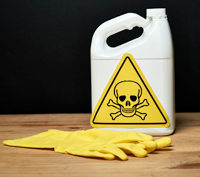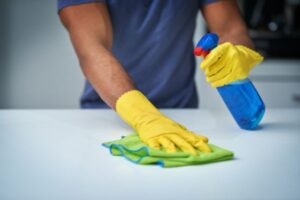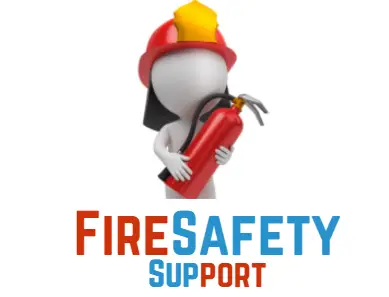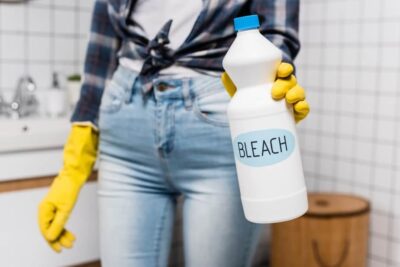Bleach is an important tool in the world of cleaning, especially when it comes to your home. It’s a great way to disinfect and deodorize, and it can also help you get rid of stains on your clothes, bedding, and other items. As useful as it is, can it cause any havoc, is bleach flammable, and how best can one use it?
No, bleach isn’t flammable. It’s a household chemical that is used to disinfect and deodorize clothes, linens, and other household items. Bleach is highly effective at killing bacteria and mold; however, it can’t actually burn anything.
Take note that it is not flammable, but it can be toxic. Bleach, as a substance, does have inherent flammability that can be a concern for you and your family. However, the fumes from the substance itself are not considered to be a fire hazard per se.
The main concern with using bleach is that it can cause chemical burns if it comes into contact with your skin or eyes. Bleach does contain sodium hypochlorite, which can cause severe irritation to the mucous membranes in your respiratory tract and eyes if it comes into contact with them.
What is bleach?

Bleach is a type of cleaning product that can be used to whiten clothes, remove stains, and clean surfaces. Bleach is usually made up of sodium hypochlorite (NaClO) and water in various ratios. It is a highly acidic compound that reacts with organic material to produce oxygen gas and hypochlorous acid.
When you pour bleach onto a surface, the oxygen in the air reacts with the chlorine in the bleach to form chlorous acid. This reaction causes the surface to get rid of dirt and stains, as well as makes it easier for you to clean with soap or detergent later on.
Types of bleach
There are three main types of bleach: chlorine bleach, non-chlorine bleach, and oxygen bleach.
- Chlorine bleach
Chlorine bleach is often used in a laundry room to kill germs that cause illnesses such as colds and the flu. It can also be used in swimming pools to help prevent the growth of algae and other organisms. Chlorine bleach is made up of sodium hypochlorite, which is highly reactive with moisture.
- Non-chlorine bleach
Non-chlorine bleach contains less than 1 percent chlorine by weight. It’s commonly used for cleaning textiles and fabrics such as carpets, upholstery, and bedding. It works by breaking down organic matter into simpler substances that bacteria cannot use as food sources.
- Oxygen bleach
Oxygen bleaching agents form ozone when combined with oxygen gas from air or water. They’re often used to disinfect hard surfaces like kitchen countertops and bathroom sinks by killing germs without damaging the surface’s finish or causing damage to decorative materials like wood trim around cabinets.
Is bleach toxic?
No, bleach is not toxic. Bleach is a disinfectant that has been used for decades to disinfect water and also as an additive in laundry detergents and household cleaners.
It’s also used in industrial settings where it’s applied to surfaces that can be exposed to harmful chemicals and bacteria, such as food processing facilities and hospital equipment.
Bleach is considered safe for most people when used according to label instructions. However, it can be harmful if you have certain medical conditions or if you swallow too much of it or absorb it through your skin. If you experience any of these symptoms after using bleach, see your doctor immediately.
Is bleach flammable?
Bleach is not flammable. Bleach is a compound of hydrogen and oxygen with an active oxygen group that can break down organic compounds. It’s used to clean many different types of surfaces, including floors, clothes, and textiles.
It’s important to note that bleach can stain some materials and fabrics, so you should test for colorfastness before using it on something expensive. Bleach can also cause skin irritation if it gets into the eyes or mouth.
Can bleach go on fire?
No, bleach will not go on fire. Bleach is a base and a pH neutralizer that can be used to clean many different things. It’s generally safe to use around food, but if you’re cleaning your kitchen with it, you might want to make sure you’re wearing rubber gloves.
If you’re concerned about the safety of bleach in your home, don’t worry, as you can wear rubber gloves when working with it. But don’t use it in your car or on pets.
Is bleach corrosive?
Yes, bleach is corrosive. Its active ingredient, sodium hypochlorite (NaOCl), is highly reactive and will react with many substances, including metal, glass, rubber, and plastic.
The reaction of NaOCl with metal can cause rusting. If you’re using bleach on metal objects that are not food-grade or stainless steel, just like a toolbox or garden shed, make sure to rinse it off thoroughly before storing the object in your house or car.
If you’re using bleach on non-food-grade items like plastic or glassware, wear gloves and goggles when cleaning with bleach.

Is bleach dangerous once it dries?
Yes, bleach is dangerous once it dries. Bleach is a chemical that can cause burns and other injuries if it comes into contact with your skin. When bleach is exposed to air, it can form chlorine dioxide gas. This gas is highly toxic and has been known to cause severe burns in people who come into contact with it.
If you are using bleach for cleaning, be sure to wear eye protection and gloves when you’re cleaning or scrubbing surfaces. Make sure that all of the bleach has completely dried off before you start working with it again, or allow children to play near the area where you have cleaned or scrubbed.
What would happen if you poured bleach on a fire?
If you poured bleach on fire, it would probably be a bad idea. Bleach is a very strong chemical, and it mixes with water to create a toxic gas. While this looks like a great way to extinguish the fire, it actually just makes things worse. The gas would cause the fire to grow in size, which means that more people would get hurt.
If you pour bleach on fire, you should call the fire department instead. They can help you put out the fire and make sure everyone is safe.
Does bleach explode in heat?
Yes, bleach can explode in the heat. Bleach is a strong oxidizing agent, which means it will catch fire when exposed to high heat. This is especially true if you mix it with other chemicals that are also strong oxidizers and/or combustible materials (like paper or wood).
The best way to avoid this is to use bleach safely, following all the instructions on the bottle. If you do mix bleach with other chemicals or combustible materials and the mixture becomes too hot, get rid of the mixture or stay away from it.
Is bleach carcinogenic?
Bleach is not carcinogenic. Bleach can cause staining of the skin and eyes and may cause irritation to your skin if it comes into contact with it. It can also stain some fabrics.
Can bleach burn skin?
Yes, bleach can burn skin. Bleach is a chemical that is used for cleaning and disinfecting fabrics, paper, and other surfaces. When bleach is applied to the skin, it can cause a chemical burn. The damage from this bleaching process may not be immediately obvious to the skin. It could take several hours or days before any symptoms appear.
Although this burning sensation may not be painful at first, it can lead to problems with your skin and eventually cause scarring.
If you notice any of these symptoms after using bleach on your skin, you should see your doctor.
- Irritation or pain in your eyes
- Dryness or flaking on your face, neck, or scalp
- Eczema-like rash around your mouth or nose
- Redness or swelling of the face

Is bleach harmful to the environment?
Yes, bleach is harmful to the environment. If you want to be environmentally friendly, you should use a non-bleach alternative like vinegar or baking soda.
Bleach has a negative impact on the environment, and below is proof of that:
In the first place, bleach burns plant life and causes soil to become sterile. Because of this effect, bleach causes more damage than it prevents in agricultural areas.
In addition to its effects on agriculture, bleach has also been shown to pollute waterways. Bleach contains chlorine which, combined with other chemicals, can cause eye irritation and even blindness if ingested by fish or other animals that live in these waterways.
The biggest environmental impact of bleach is that it releases formaldehyde when it reacts with oxygen. This chemical has been linked to respiratory problems in humans if inhaled or ingested.
Bleach is also corrosive to metals like copper and aluminum, so it may leave behind any number of stains on your home’s appliances and fixtures.
Does bleach burn skin?
Yes. Bleach does burn skin. Bleach is an oxidizing agent that contains oxygen, hydrogen peroxide, and chlorine. It also has a high pH level and can cause damage to your skin if you use it on your hair or scalp too often.
If you have sensitive skin, try diluting the bleach in water before applying it to your scalp. If this doesn’t work, you may want to try a milder bleaching agent instead of bleach itself. Some examples are hydrogen peroxide (3%), lemon juice (0.25%), baking soda (1%), and vinegar (2%).
How to treat bleach burn on the skin
Bleach burns can be pretty painful and can leave your skin in bad shape. While it’s not uncommon for people to experience minor stinging or burning when they use bleach, if you experience more severe symptoms, you should seek medical attention right away.
Bleach burn symptoms include:
- Redness or swelling at the site of the bleach accident
- Pain or tenderness in the affected area
- Dryness or peeling of skin around the affected area
- Blistering, cracking, or crusting of the affected area
If the area affected by the bleach has become red and swollen, there are several things you can do at home in order to treat it:
1) Apply aloe vera gel or vitamin E oil directly onto the affected area. Do this twice daily for about a week until your skin has healed fully.
2) Wash with warm water and mild soap every day until your skin begins to heal again (about 2-3 weeks). You can treat minor burns with regular soap and water but avoid using anything that contains alcohol unless instructed by your doctor because it could make them worse instead of better.
3) Cover with bandages if needed or wrap with gauze strips.
Safety tips when using bleach
Use the following safety tips when using bleach:
- Do not use bleach in an enclosed area, such as a bathroom or closet.
- Do not mix bleach with other cleaners or chemicals, which can cause serious burns or explosions.
- Use caution when pouring bleach onto surfaces like floors, as it is heavier than water and can be dangerous to pour onto hard surfaces if you are not careful.
- Wear protective gloves and goggles.
- Keep the bleach away from your skin and eyes. You can use a splash guard to keep the bleach from getting on your skin when you’re mixing it with water, but be careful not to get any of it in your eyes, and don’t rub or scratch them after you’ve rinsed them out.
- Use bleach only in a well-ventilated area.
Conclusion
Bleach is an essential household product. It’s used to disinfect the laundry, kill bacteria and remove stains. You can use bleach to clean your home and clothes. This article will help you decide which type of bleach to use, how much to use and what safety measures are needed when using bleach.
Also, it also educates you on the danger of bleach. The question: is bleach flammable is common online, and there are much information that can mislead, which is the reason I choose to share my personal experience with bleach on this page.

